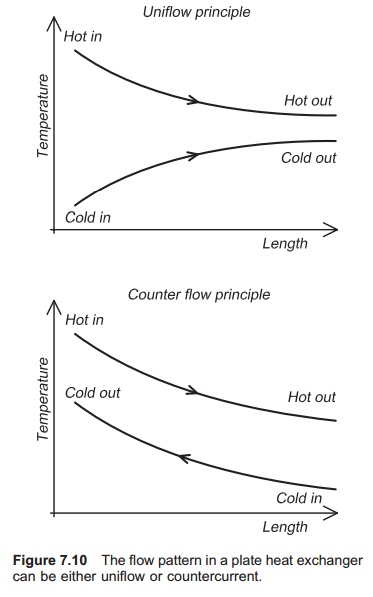Chapter: Aquaculture Engineering : Heating and Cooling
Flow pattern in heat exchangers
Flow pattern in
heat exchangers
Two flow principles are used in heat exchangers: with-current or
countercurrent, the latter only in plate exchangers of particular construction
(Fig. 7.10). In the with-current system, the liquids on both sides of the
exchange material flow in the same direction, or approximately in the same
direc-tion as in the shell and tube exchanger. In this case the temperature
gradient between the media is high at the start but gradually decreases. The
highest possible temperature that can be achieved in the cold liquid being
heated is the mean temperature between the two flowing liquids. This requires
equal flow of both liquids; otherwise the temperature depends on the flow ratio
of the two liquids. In a countercurrent exchanger the cold media flows in

the opposite direction to the hot media. The tem-perature of the
cold media thus gradually increases and the hot water is correspondingly
chilled. With a countercurrent exchanger, the temperature of the cold media can
be raised to almost the temperature of the hot media, depending of the size of
the exchanger.
Example
Find the LMTD for a countercurrent
heat exchanger having the following temperatures: hot water into the exchanger,
t1= 11┬░C; hot water out of the
exchanger, t2= 5┬░C; cold water into the exchanger,
t3= 3┬░C; cold water out of the
exchanger, t4= 7┬░C.
DT1 =t1 ŌłÆ t4
= 11 ŌłÆ 7 = 4
DT2 =t2 ŌłÆ t3
= 5 ŌłÆ 3 = 2
LMTD = 4-2 / ln( 4/2)= 2.89
With parallel/linear temperature
equalizing the answer would be slightly higher at 3.0. The way to achieve the
conditions shown in the example is to have different media flow rates on the
two sides of the transfer plates. If there are no energy losses to the
surroundings and the water flow in both circuits is equal T1 will
equal T2 and this value can then be used for further calculations.
Related Topics